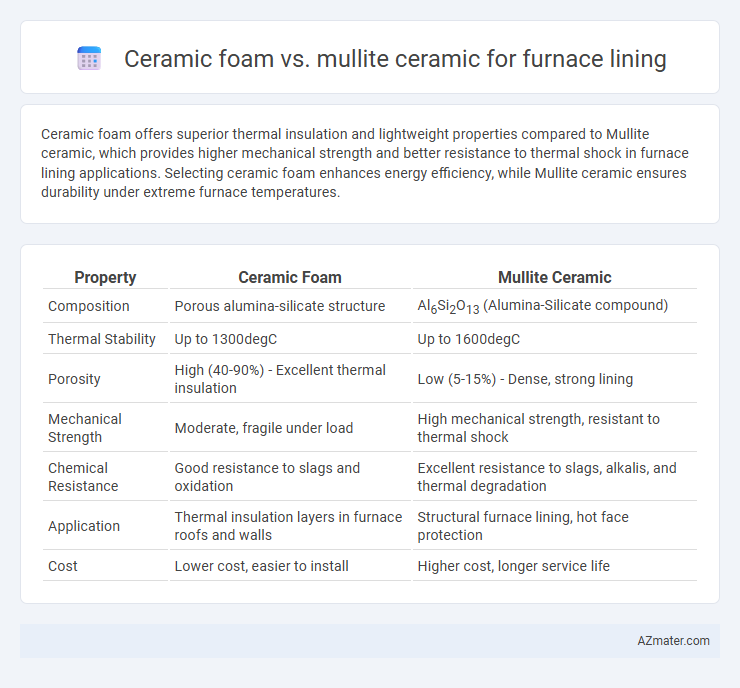Ceramic foam offers superior thermal insulation and lightweight properties compared to Mullite ceramic, which provides higher mechanical strength and better resistance to thermal shock in furnace lining applications. Selecting ceramic foam enhances energy efficiency, while Mullite ceramic ensures durability under extreme furnace temperatures.
Table of Comparison
| Property | Ceramic Foam | Mullite Ceramic |
|---|---|---|
| Composition | Porous alumina-silicate structure | Al6Si2O13 (Alumina-Silicate compound) |
| Thermal Stability | Up to 1300degC | Up to 1600degC |
| Porosity | High (40-90%) - Excellent thermal insulation | Low (5-15%) - Dense, strong lining |
| Mechanical Strength | Moderate, fragile under load | High mechanical strength, resistant to thermal shock |
| Chemical Resistance | Good resistance to slags and oxidation | Excellent resistance to slags, alkalis, and thermal degradation |
| Application | Thermal insulation layers in furnace roofs and walls | Structural furnace lining, hot face protection |
| Cost | Lower cost, easier to install | Higher cost, longer service life |
Introduction: Comparing Furnace Lining Materials
Ceramic foam and mullite ceramic are widely used materials for furnace lining due to their excellent thermal insulation and high-temperature resistance properties. Ceramic foam offers superior porosity and lightweight characteristics, enhancing thermal shock resistance and reducing energy consumption, whereas mullite ceramic provides exceptional mechanical strength and chemical stability at elevated temperatures up to 1750degC. Comparing their thermal conductivity, mullite ceramic typically ranges from 2 to 4 W/m*K, while ceramic foam can achieve lower values around 0.3 to 1 W/m*K, making ceramic foam more efficient for insulation in high-temperature furnaces.
Overview of Ceramic Foam
Ceramic foam is a porous, lightweight material characterized by high thermal insulation and excellent resistance to thermal shock, making it ideal for furnace lining applications. Its open-cell structure allows for superior heat retention and energy efficiency while protecting furnace walls from extreme temperatures. Compared to mullite ceramic, ceramic foam offers enhanced insulation properties but may have lower mechanical strength, requiring careful consideration based on specific furnace operating conditions.
Overview of Mullite Ceramic
Mullite ceramic for furnace lining is prized for its exceptional thermal stability, high melting point of approximately 1840degC, and excellent resistance to thermal shock and chemical corrosion. Its unique crystal structure provides superior mechanical strength and low thermal expansion, making it ideal for harsh furnace environments where durability and insulation are critical. Compared to ceramic foam, mullite ceramic offers enhanced structural integrity and longevity, ensuring efficient temperature control and energy savings in industrial applications.
Key Properties Comparison: Thermal Insulation
Ceramic foam offers superior thermal insulation due to its highly porous structure, providing low thermal conductivity and excellent heat retention for furnace linings. Mullite ceramic, while denser and less porous, delivers robust mechanical strength and thermal shock resistance but with slightly higher thermal conductivity. The choice between ceramic foam and mullite ceramic hinges on balancing insulation efficiency against durability requirements in high-temperature furnace environments.
Durability and Resistance to Thermal Shock
Ceramic foam and mullite ceramic differ significantly in furnace lining durability and thermal shock resistance, with mullite ceramic offering superior structural integrity and longevity due to its high alumina content and crystalline structure. Ceramic foam provides excellent thermal insulation and energy efficiency but is more prone to mechanical wear and thermal shock damage under rapid temperature fluctuations. Mullite's enhanced resistance to thermal expansion and spalling makes it the preferred choice for high-temperature, industrial furnace applications where durability is critical.
Chemical Stability in High-Temperature Environments
Ceramic foam and mullite ceramic both exhibit exceptional chemical stability in high-temperature furnace environments, but mullite ceramic offers superior resistance to thermal shock and chemical corrosion due to its stable alumina-silica crystalline structure. The alumina content in mullite enhances its inertness against slags, alkalis, and acidic gases typically present in industrial furnaces, maintaining integrity at temperatures exceeding 1700degC. Ceramic foam, while providing excellent thermal insulation and gas permeability, may have limited long-term chemical resistance compared to dense mullite linings under aggressive high-temperature conditions.
Mechanical Strength and Structural Integrity
Ceramic foam exhibits high mechanical strength due to its interconnected porous structure, providing excellent shock absorption and thermal insulation for furnace linings. Mullite ceramic offers superior structural integrity with high creep resistance and stability at temperatures exceeding 1600degC, making it ideal for prolonged exposure to extreme furnace conditions. Compared to ceramic foam, mullite ceramics deliver enhanced durability and resistance to thermal spalling, ensuring longer service life in harsh industrial environments.
Energy Efficiency and Operational Costs
Ceramic foam offers superior thermal insulation with low thermal conductivity, significantly reducing heat loss and enhancing energy efficiency in furnace lining applications compared to mullite ceramic. Mullite ceramic, while durable and thermally stable at high temperatures, typically has higher thermal conductivity, leading to increased energy consumption and operational costs. Choosing ceramic foam lining can result in lower fuel usage and maintenance expenses, improving overall furnace performance and cost-effectiveness.
Application Suitability: Ceramic Foam vs Mullite
Ceramic foam is highly suitable for furnace lining due to its excellent thermal insulation and shock resistance, making it ideal for energy-efficient high-temperature applications. Mullite ceramic offers superior mechanical strength and chemical stability, excelling in environments exposed to abrasive slags and corrosive gases. Selection between ceramic foam and mullite depends on balancing insulation needs with durability requirements in specific furnace operating conditions.
Conclusion: Which Material is Better for Furnace Linings?
Ceramic foam offers superior thermal insulation and lightweight properties, making it ideal for applications requiring energy efficiency and rapid heat cycling. Mullite ceramic excels in mechanical strength and thermal shock resistance, benefiting high-temperature environments with demanding structural integrity. For furnace linings, the choice depends on specific operational priorities: ceramic foam suits insulation-focused designs, while mullite ceramic is better for durability under intense thermal and mechanical stress.

Infographic: Ceramic foam vs Mullite ceramic for Furnace lining
 azmater.com
azmater.com